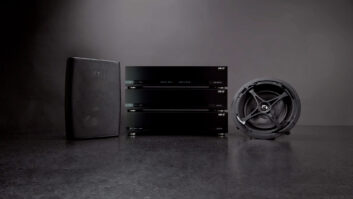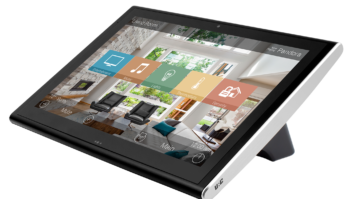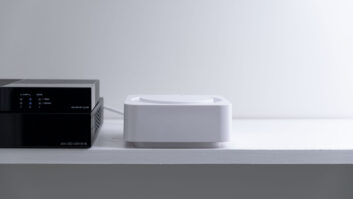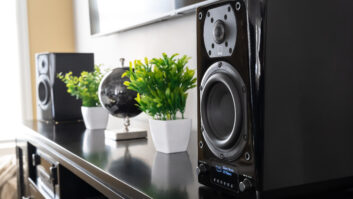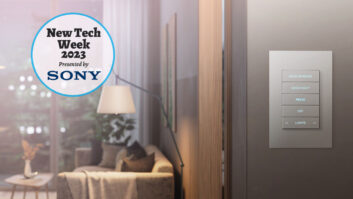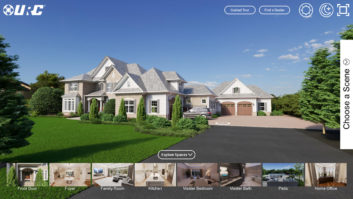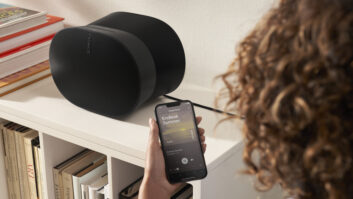Think of this less as a review and more as a breathless introduction. Imagine that we lived in some inexplicable alternate universe in which all-you-can-eat buffets were the ultimate five-star dining experience. Envision the poor epicurean scribe tasked with reviewing such establishments for the discriminating binge-and-purger, faced with the choice between reducing each sumptuous smorgasbord to its bare essence at the expense of a comprehensive overview, or grocery-listing its offerings at the expense of a truly worthwhile qualitative assessment. That’s exactly how I felt when the tasked with reviewing URC’s new Total Control System.

URC’s Total Control boasts a consistent user interface across tablet platforms and on its on handheld remotes, such as the TRC-1280.
Total Control is a radical expansion beyond the core experience of the company’s Complete Control line, with central processors replacing RF receivers and IR repeaters, and with capabilities that quite frankly make Complete Control blush. It’s adept at lighting, and thermostats, and network distributed audio. It covers cameras, and security, and I’m pretty sure if you had lions and tigers and bears (oh my!) at home, it would figure out a way to control them, too. There’s even a networked AV receiver in the line that allows you to integrate a turntable into your whole home audio system, for goodness’ sake, and a whole host of digital multi-room music servers and amps that allow you to retrofit a sophisticated distributed audio system without any central wiring required.
I could go on for another 1,097 words about all of the things that Total Control can do, but if you want to do all of those things, you’re probably already aware that Total Control does them. And if your bread and butter lies more with the simple one- or two-room home theater systems, you’re probably thinking, “Why bother learning a complicated new system when Complete Control serves me just fine?”
That’s the attitude with which I went into URC’s Mission Control training for Total Control last month. I flew up to White Plains, NY, not just to learn how to program with the new URC Accelerator software (or, more accurately to unlearn what I have learned over the years about programming with plain old, vanilla CCP), but also to figure out how much of the system I needed to review, knowing I would get a taste of it all in the intense two-day course. And yes, by the end of those two days I had completely programmed two racks and five rooms’ worth of AV, security, and comfort gear, but ironically, walked away requesting a two-room review system that, on the surface, doesn’t seem to push things much further than an MX-5000, MX-780, and a couple of MRF-350 base stations could do.
To the untrained eye, it may look like that’s exactly what I have with my new Total Control system. In fact, though, it’s an MRX-10 advanced network system controller (the minimum requisite piece of kit for every Total Control system); an MRX-1 network controller (for the bedroom home theater system); a TRC-1280 touchscreen handheld remote (the MX-5000’s TC brother, which is aesthetically the same, but passes its brains off to the MRX-10); a TRC-780 handheld remote control (ditto, but equivalent to the MX-780 in form); an MFSPOE-8 Mac filtering switch with PoE (for powering a TKP-2000 in-wall two-way network touchscreen, and also for making sure that when I add multi-room streaming to my Total Control system, it doesn’t overload my router); and a whole lot of potential for easy future expansion.

URC’s MRX-10 advanced network system controller is the minimum requisite piece of kit for every Total Control system, but the TRC-1280 touchscreen handheld remote and TKP-2000 in-wall two-way network touchscreen are just two of many user interface options.
That can come later, though. For now, let’s talk about why you want to adopt Total Control even if the bulk of your revenue comes from programming local entertainment control systems. For one thing, programming is way simplified under the URC Accelerator. At Mission Control, again, we programmed five rooms and two full racks in a couple of hours. That’s with the racks built, though. Here at home, where I had to do all of the rewiring and installing and programming myself, I had two complete home theater systems up and running, with full control on two iPads and two iPhones I might add, in about half a day.
And that’s with having to build all of my device drivers myself, too. Did I mention that? URC Accelerator is now built on a foundation of device drivers, which tell the system that, say, the power button turns on a device, and that “BDP” and “TV” are inputs. You’ll spend some time programming these drivers, sure, but that work on the front end saves you a lot of time on the back end, especially if you install a lot of the same gear in different homes.
I’m reducing an incredibly sophisticated piece of software into an overly simplistic sentence here, but fundamentally, once you’ve built those drivers, programming the system amounts to getting your network settings in place, telling URC Accelerator which box is connected to which input on which other box, poking a few buttons, and having your UI layouts and macros largely built for you. There’s tweaking to be done, sure–especially with the macros–but not nearly as much as you would think. And if you get your device drivers right the first time–telling the system how long an AV receiver takes to power up, for instance–you’ll have way less tweaking to do.
Just for giggles, I let the system Accelerate my macros without digging into any of the “ifs” and “elses” I love tinkering with in CCP. To my amazement, I ended up with a system that works incredibly well and only plan on tweaking a little because I’m OCD when it comes to macro efficiency.
Dig a little deeper than a mere surface look, though, and it’s obvious that even this meager core entertainment control system does so much more than I could with CCP. Instead of having remotes tied down to one room–one in the den, one in the bedroom–my wife and I are using the TRC-1280 and TRC-780 as his and hers remotes (the 1280 being his, the 780 hers—sorry, babe, but he who programs the toys gets to keep the better ones). Say I’m in the bedroom watching the Dish Hopper. She touches the bedroom button on her remote (or iPad, or iPhone), and it automatically jumps to the appropriate screens for controlling the Hopper. If I back out to the main page and select “watch Blu-ray,” her remotes and “iDoodads” instantly skip to the appropriate screens. There’s no chance of crossing wires or having remotes get out of sync here, because the MRX-10 and MRX-1 are the ones actually doing the controlling, not the remotes. There has been some mischief involved when it comes to channel surfing, though.
The other beautiful thing is that all the layouts and graphics are consistent across all interfaces–remotes, iDevices, and the TKP-2000. If you can use one, you’re intimately familiar with all the others. Granted, the ability to do crazy customized graphics and custom buttons on every screen is mostly gone, but I’ll gladly forfeit that for the consistency, the ease of use, and the gorgeous pre-made UI screens.
Even with such a small system, I feel like I’ve barely scratched the surface. But that’s the beauty of Total Control. You can build a very simple system with a lot of functionality for not much more money than a comparable Complete Control system, but which has the potential for nigh-infinite expandability. It’s also a system you won’t have to worry about competing with Amazon on sales for, since Total Control is only being sold directly through URC–not distributors–and each MAC address of each device is tracked, so if you do decide to try to make a quick buck by selling Total Control systems to DIYers online, you’re going to get busted.
Keep an eye on these pages for further reviews that really dig into the networking potential and distributed audio capabilities of Total Control in future issues.
Contact
800.901.0800
www.universalremote.com
Kudos
Total Control is such a robust, sophisticated, complete home control solution, with such radically different (and intelligent) programming capabilities, that one review can only hope to hint at its potential.
Concerns
Total Control is such a robust, sophisticated, complete home control solution, with such radically different (and intelligent) programming capabilities, that one review can only hope to hint at its potential.
Specs
MRX-10 Advanced Network System Controller:
-Stores and issues commands and macros for all IP, IR, RS-232, relay- and sensor-controlled devices in one system
-Provides 2-way communication with Total Control remotes and keypads
-Expandable via LAN and MRX-series sub-base stations
-Routes macro steps to IR, RS-232, Relays and Sensors to multiple MRX-1 Network Base Stations on the network
-Ports include IR (8), RS-232 (4), Sensor (4), Relay (2), 12-volt output (2)
